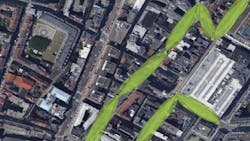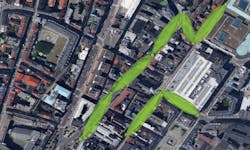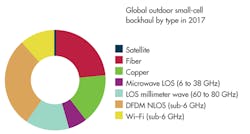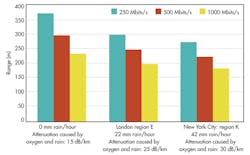On August 9, the Federal Communications Commission (FCC) announced significant modifications to its Part 15 rules, which govern unlicensed communication in the 57- to 64-GHz band, more commonly known as 60-GHz wireless.1
Related Articles
- What's The Difference Between 3G And 4G Cellular Systems?
- Spectrum And Backhaul Inhibit Wireless Growth
- 4G Resolves Challenges On The Network's Edge
The new rules permit an increase in permitted power for outdoor operations and could, according to the FCC, “provide wireless broadband network connectivity over distances up to a mile at data rates of 7 Gbits/s, potentially relieving the need and expense of wiring facilities or using existing facilities with less capability.”
The FCC further says the new rules will “enhance the use of unlicensed spectrum as a relatively low-cost, high-capacity short-range backhaul alternative to connect wireless broadband networks and for other wireless applications.”
The new rules could enable significant benefits to the mobile operators, reducing the cost of setting up a network and simplifying the process of adding capacity to the network in line with demand. They will also enable a huge market for such equipment and drive innovation in this multi-gigabit band.
This file type includes high resolution graphics and schematics when applicable.
The 60-GHz Band In Backhaul
The widespread use of the 60-GHz band dates back to the 1990s, when the FCC adopted rules for unlicensed operations over a 7-GHz wide band: the 57- to 64-GHz band. This is a very wide bandwidth, making this spectrum very desirable for high-capacity uses, both as networking equipment indoors such as streaming lag-free HD video from a Blu-ray player or tablet to the television, and, vitally for backhaul, point-to-point (P2P) fixed operations outdoors, providing broadband access to adjacent structures in commercial facilities to extend the reach of fiber-optic networks.
The FCC has now ruled that outdoor operations between fixed points can use a higher power, increased from +40 dBmi up to a maximum of +82 dBmi with +51-dBi gain antennas (Fig. 1). To benefit, equipment needs to use highly directional antennas. Because this increase could interfere with other users and networks, the FCC has linked the maximum power permitted to the antenna beam width.
In short, the rule change permits outdoor devices to deliver this high-speed data over longer distances and further cuts the cost of deploying a network.
Why Now: The Rise Of 4G
The speed at which we create and consume data is increasing. Back in 2010, Eric Schmidt (then CEO of Google) famously said: “Every two days, we create as much information as we did from the dawn of civilization up until 2003.” And an even more extreme figure will be true of data consumption today. Indeed, Cisco currently predicts that 1.4 zettabytes (1021 bytes) will flow over global networks by 2017.2 In North America alone, 1.3 exabytes (1018 bytes) of Internet protocol (IP) traffic will flow every day, including both fixed and mobile traffic.
The emerging 4G LTE standard has been designed to provide consumers with access to typical data rates of 30 Mbits/s and peak data rates of up to 100 Mbits/s for the current generation of smart-phone devices based on 3GPP LTE release 7 or 8. New devices currently in development will have the potential to extend theoretical mobile data rates to greater than 1 Gbit/s based on the features included in later LTE releases such as 3GPP release 12. However, data rates that can be achieved on deployed networks will be a function of capacity. As cells hit capacity limits, operators will have to add smaller and smaller cell cites known as microcells and picocells.
Today’s average backhaul capacity is 35 Mbits/s per cell. This needs to increase to 1 Gbit/s per cell in just five years to support this mobile data growth. Indeed, in a recent webinar, Qualcomm went on record saying “To solve the 1000x mobile data challenge, we need more small cells everywhere.”3
As a result of this rise in mobile data, LTE operators anticipate that more than half of their annual capital expenditures will be allocated to meet this demand for smaller cell sizes, with 72,000 small cells predicted in London by 2015 and a market forecast of $2.7 billion by 2017 (Fig. 2).4
This is particularly relevant for urban deployments where the exceptionally high density of users requires increasingly small cells and, therefore, increased costs. Furthermore, this means there is a need for a high density of basestations (connected via high-bandwidth data links to the core network) and the freedom of where they are placed. Until now, this backhaul requirement has been serviced through a combination of fiber-optic and licensed point-to-point (P2P) microwave radio links, operating at selected bands from 6 to 38 GHz.
But current wireless sub-6-GHz non-line-of-sight (NLOS) and 60/80-GHz line-of-sight (LOS) systems do not deliver the necessary capacity at acceptable cost points, and the high link cost of licensed bands has acted as a significant economic brake on the rollout of these P2P links. A typical license costs, on average, roughly $200 per year in the U.S. Those in Europe are even more expensive, costing 10 times this figure. Licensed microwave equipment costs are typically $10,000 to $20,000 per unit as well.
High-capacity optical fiber can provide an ideal backhaul connection, but fiber often is not available at the locations where small cells are required. Also, laying new fiber requires costly and disruptive construction works, which is hardly ideal if you’re trying to grow the network in line with subscriber demand.
The FCC’s further backing of the 60-GHz band will encourage operators and OEMs to develop and deploy lower-cost backhaul products that will, in turn, significantly simplify network rollout by reducing the disruption and capital expenditures per small cell. Furthermore, because the 60-GHz band has 7 GHz of bandwidth and its typical range is limited to about 1 km, it supports mesh networking with significant frequency reuse, as long as a few key technological challenges are addressed as well.
TDD Vs. FDD
60-GHz backhaul equipment already exists. It generally uses frequency division duplex (FDD), though, which requires complex diplexor filters to be implemented and the use of guard bands for the separation of transmit and receive frequencies. This leads to potential inefficiencies in the use of available frequencies as the guard band can consume a significant portion (1 to 2 GHz) of the useable frequency band.
Diplexors also add significant loss in both the transmit and receive paths, with 2- to 4-dB loss being typical. For a single P2P transmission, this wouldn’t be a problem. But backhaul requires multiple adjacent links, so frequency reuse is essential to avoid interference and further increase capacity in very dense network deployments.
In contrast, time division duplex (TDD) technologies, like those used in Wi-Fi and the 60-GHz version of Wi-Fi also known as WiGig, allow the complete band to be used for both send and receive. Moreover, the traffic allocated to uplinks and downlinks can be dynamically adjusted to match the current traffic profile where downlink data traffic to the user device usually dominates.
Modulation Schemes
WiGig, which is based on the IEEE 802.11ad standard, can deliver from 1 to 7 Gbits/s within a 2-GHz wide channel through a flexible combination of modulation types (binary phase-shift keying or BPSK, quadrature phase-shift keying or QPSK, 16-phase quadrature amplitude modulation or 16QAM, and 64-phase quadrature amplitude modulation or 64QAM), access modes (single carrier and orthogonal frequency division multiplexing, or OFDM), and advanced channel coding using low-density parity check (LDPC). These modes are dynamically selecting during link setup.
In comparison, the typical backhaul needs for an LTE small-cell basestation of less than 1 Gbit/s can typically be accommodated by using a relatively low-order modulation such as QPSK, which can deliver more than 2 Gbits/s. This is both more robust than the higher-order (up to 1024 QAM) schemes used in narrow-channel microwave backhaul modems and has the potential to extend the data rate through deployment of higher-order modulation modes in future versions.
Whilst WiGig may be used “out of the box” for 2-Gbit/s QPSK links, backhaul applications require the flexibility of trading data rate and operational distance. One other option, therefore, is to increase the radio link budget through the use of reduced channel bandwidth. For example, each halving of the channel bandwidth improves the receiver sensitivity by an additional 3 dB (Fig. 3). Here, a 1000-Mbit/s full-duplex link (2-Gbit/s QPSK) is further scaled by half and a quarter to illustrate the tradeoff of range versus data rate under different rain fade conditions.
A flexible baseband architecture like that used in the Blu Wireless Technology HYDRA 60-GHz intellectual property allows this scaling of frequency channel bandwidth to enable this increase in range and to cope with differing operator scenarios.
Data Packetization
Data packetization for LTE backhaul is particularly challenging. Unlike standard P2P networks, the wireless mesh networks used to transmit data between points add an extra level of complexity. Each small cell needs to know if it is merely relaying (via 60 GHz or other backhaul connection mechanisms) data or transmitting it via the mobile network’s basestation to the mobile smart phone.
This data packetization is controlled via the media access controller (MAC) function. This is slightly different from the standard WiGig MAC. To implement WiGig technology for LTE backhaul, the baseband platform requires the flexibility to cope with both requirements.
One proposal is to use the OpenFlow as a MAC framework to define an industry standard backhaul application programming interface (API). However, for the time being there is no fixed standard. As a result, we’re cooperating with several equipment vendors and operators to ensure our intellectual property complies universally.
Phased Array Antennas
The new FCC rules stipulate a narrow antenna beam with as low as a 0.4°beam width. As small cells for LTE backhaul transmit over distances of several hundred meters, even a position change of a fraction of a degree will have a negative effect on the link performance and therefore the quality of the mobile network.
Furthermore, LTE backhaul small cells will be positioned on lampposts and other street furniture, so they will be at the mercy of both the elements and accidents. This leads to one final key challenge facing the operators when deploying 60 GHz: how to easily install, align, and provide in-life adjustments for backhaul links.
Electronic antenna steering using phased array antenna (PAA) technology offers an ideal solution to these problems. Originally designed for military applications, it is now a mature technology, and 60-GHz PAA technology is becoming available at cost points compatible with the commercial constraints for small-cell backhaul. PAA technology also fits well with the emerging use of self-optimizing networks (SONs), which could utilize PAA to dynamically steer antenna connections and thus re-configure network coverage for very high-capacity hotspots.
The Market And Its Key Players
All major mobile operators, from Europe’s Orange, EE, and Vodafone through Japan’s KDDI to Clearwire, Sprint, and Verizon in the U.S., are all actively assessing the 60-GHz backhaul technology. The FCC’s recent ruling will likely speed their efforts.
In addition, products are beginning to hit the market from vendors such as NEC’s Pasolink. Smaller vendors are also producing interesting solutions technology. For example, Sub10 Systems showcased its 60-GHz backhaul equipment at Vodafone’s Mobile World Congress stand. Siklu’s millimeter-wave backhaul equipment is noteworthy as well.
The key question facing all operators and equipment vendors is how to reduce the total cost of ownership (TCO) of backhaul equipment. The current generation of 60-GHz backhaul products typically uses expensive discrete RF, analog, and digital signal processing components based on a combination of FPGA and high-end programmable DSP devices.
With the continued development of WiGig, highly integrated 60-GHz devices will begin to reach the market in high volumes from 2014 onwards. The Blu Wireless HYDRA baseband core will be integrated within several of these chips, which in turn will significantly reduce the equipment costs for 60-GHz backhaul applications.
According to ABI Research, 2 billion Wi-Fi chips (2.4 and 5.8 GHz) will be shipped in 2013. ABI further estimates that by 2018, Wi-Fi chips incorporating 60 GHz will add a further 1.5 billion units per annum to this market. By using these economies of scale, the potential for cost reduction of 60-GHz backhaul equipment is very considerable.
Clearly, the intersection of increased demand for cost-effective backhaul for LTE mobile networks and the reducing cost of 60-GHz technology as being deployed in the Wi-Fi market offers the potential to deliver backhaul at performance points and TCO compatible with operator requirements. 2014 and 2015 will prove to be very interesting times for those of us working in this very exciting sector.
References
1. “FCC Modifies Part 15 Rules For Unlicensed Operation in 57-64 GHz Band,”
http://www.fcc.gov/document/fcc-modifies-part-15-rules-unlicensed-operation-57-64-ghz-band
2. “Cisco predicts massive data networking growth by 2017,” Jack Clark, The Register, May 30, 2013, http://www.theregister.co.uk/2013/05/30/cisco_vni_report/
3. “1000x: More Small Cells,” 4G-Portal, October 17, 2012, http://4g-portal.com/1000x-more-small-cells-presentation-from-qualcomm
4. “Small Cell Architectures: U.S. LTE Network Infrastructure CapEx Spending Forecast, 2011-2016,” https://igr-inc.com/Advisory_And_Subscription_Services/Small_Cell_Architectures/us_lte_capex_forecast_2016.asp
Mark Barrett is CMO at Blu Wireless Technology and a leader in the use of 60-GHz technologies for backhaul and WiGig applications. He has more than 30 years of experience in wireless technology and product development. Previously, he led the development of several applications of array antennas and digital beamforming to satellite, radar, and mobile communications applications (smart antennas). He also instigated and led the Tsunami series of multi-company European projects, which demonstrated the use of smart antennas for 2G and 3G mobile systems.
About the Author
Mark Barrett
CMO
Mark Barrett is CMO at Blu Wireless Technology and a leader in the use of 60-GHz technologies for backhaul and WiGig applications. He has more than 30 years of experience in wireless technology and product development. Previously, he led the development of several applications of array antennas and digital beamforming to satellite, radar, and mobile communications applications (smart antennas). He also instigated and led the Tsunami series of multi-company European projects, which demonstrated the use of smart antennas for 2G and 3G mobile systems.




